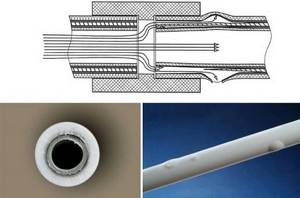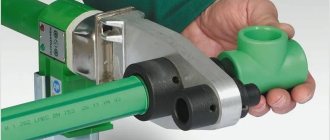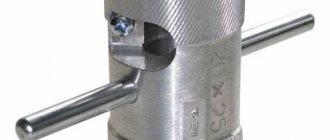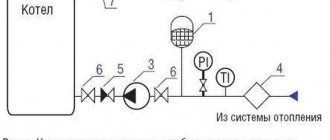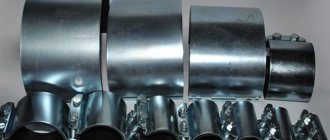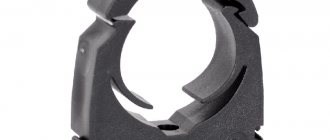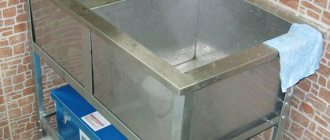What are compensators
When the temperature changes, pipelines undergo linear deformation. To compensate for this, flexible elements are installed on communications. Due to their elasticity, they compensate for thermal expansion and part of the pressure when it sharply increases, returning to their original form after the cessation of exposure. Devices for polypropylene pipes are usually made in the form of a loop, but depending on the installation conditions, other designs are also used. Such products can be purchased at the store or made independently.
Mounting features
The main fastening methods in this case are:
- welded;
- flanged
In order to correctly install a compensation device, you need to know that most types of these devices require rigid fixation using welding.
Before installing a compensator for polypropylene heating pipes, it is necessary to check that the diameter of the pipe product and the element being installed match. Only in this way can a heating structure be made with high tightness.
It is better to entrust the installation of a flange joint to professional craftsmen. For such a joint, the installation of a counter flange will be required. This allows you to create a detachable joint, which is very convenient when carrying out repair work on a heating or water supply pipeline.
The bellows mechanism is placed on a linear short span of the line, and works great for a room where temperature changes in the coolant often occur.
Important! Before starting installation work, it is recommended to check the installed part for damage. If any are detected, this device cannot be installed.
When are compensators needed?
Since polypropylene has a high coefficient of thermal expansion, pipes made from it must be equipped with protective devices. Compensators are installed:
- on the water supply;
- when installing heated floors;
- on the sewer;
- in heating and hot water supply systems.
The devices are installed on horizontal and vertical pipes in residential buildings, industrial and administrative buildings. Their use provides:
- long trouble-free service life of the pipeline;
- turbulence damping;
- stability of pressure in pipes during pressure surges;
- protection against water hammer;
- no distortion due to thermal expansion.
Specifications
To understand the capabilities of the compensating part, you need to understand its technical characteristics. They depend on the material from which the device is made. Options:
- density - approximately 0.92 g/cm;
- wall thickness - at least 4.5 mm;
- maximum temperature – up to 95 degrees Celsius;
- color - white, gray;
Construction and plumbing stores sell products with a diameter of 20 to 110 mm. The service life declared by the manufacturer is 50 years.
When calculating the diameter of the compensator, it is necessary to determine the maximum compression and expansion of the pipe when heated. For example, we can consider a pipe with a diameter of 90 mm. Its maximum expansion is 4.2 cm, compression is 2.1 cm. The diameter is calculated depending on the maximum magnification, which is equal to ΔL/2 = 21 mm.
Classification of expansion joints
Devices for combating deformation are divided into two types: natural and structures made of elastic materials. The first uses the shock-absorbing properties of pipes. Compensators of this type can be:
- L-shaped - installed at corners.
- U-shaped - used for pipelines with temperatures above 50 ⁰C. It is recommended to stretch before installation to increase compensation limits.
- Z-shaped - used to connect branches.
- Ring – due to their shape, they have increased compensation properties.
The high-tech class includes:
- Bellows expansion joints protect against thermal expansion, vibration, and water hammer. Rotary, shear, axial, and universal varieties are available.
- Lens - designed to work on hot and cold pipelines, ventilation systems.
- Stuffing box – used for heating systems with frequent temperature changes. They can work in one- and two-sided mode if equipped with a movable glass.
Device installation
In addition to recommendations regarding calculations, there are also tips for installing expansion joints.
Firstly, it is not recommended to place fixed supports further than 10DN from the compensator itself. This is due to the fact that the transmission of the pinching moment of the support will greatly reduce the flexibility of the structure.
Secondly, it is strongly recommended to divide sections from the fixed support to the U-shaped compensator of the same length throughout the entire network. It is also important to note here that shifting the installation location of the device from the center of the pipeline to one of its edges will increase the force of elastic deformation, as well as stress, by approximately 20-40% of the values that can be obtained if the structure is mounted in the middle.
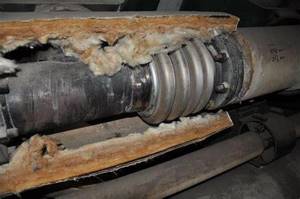
Thirdly, in order to further increase the compensating ability, stretching of U-shaped compensators is used. At the time of installation, the structure will experience a bending load, and when heated it will take on a relaxed state. When the temperature reaches its maximum value, the device will come back into voltage. Based on this, a stretching method was proposed. The preliminary work is to stretch the compensator by an amount that will be equal to half the thermal elongation of the pipeline.
Which option is better to install on polypropylene?
The range of devices offered by manufacturers allows you to select the right type for polypropylene pipelines for any purpose and installation method. Depending on the conditions of use, the following are used:
- Axial bellows-type expansion joints designed for use in heating and hot water supply systems. They are connected to pipes using couplings. The bellows is made of thin stainless steel and can withstand pressure up to 16 atmospheres at a temperature of 115 ⁰C.
- Shear devices with two corrugations - compensate for thermal expansion in 2 directions simultaneously.
- Rotary - used in places where the pipeline line changes by 90⁰.
- Universal varieties - used in small areas with branches. Compensate for transverse, angular, axial displacements. They are installed where it is not possible to use other types.
- Flanged expansion joints made of soft materials are designed to mitigate water hammer. They will smooth out minor flaws made during the pipe laying process. They are easy to install and replace since no welding is required during installation.
- Compensators in the form of coils.
- Loop-shaped ones are the simplest. They are easy to make yourself from a piece of polypropylene pipe. Despite the simplicity of the design, they successfully perform the same functions as their factory counterparts, but take up more space.
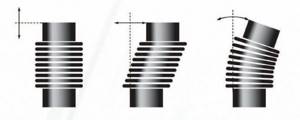
Installation: calculations and requirements
For polypropylene pipes with aluminum reinforcement, the coefficient of thermal expansion is 3×10⁻⁵ 1/°C, and for ordinary pipes it is 15×10⁻⁵ 1/°C. It follows from this that a change in temperature by 10 ⁰C increases the length in the first case by 0.3, and in the second by 1.5 mm. Knowing the length of the pipe and the limits of its temperature change, it is easy to calculate how much it will lengthen.
Suppose the heating system is installed at a temperature of 20 ⁰C, it will heat up to 100 ⁰C. The resulting difference of 80 ⁰C will cause each meter of reinforced pipes to increase by 0.3 × 8 = 2.4 mm, and for conventional pipes by 1.5 × 8 = 12 mm. If their length is 10 m, the total increase will be 2.4 × 10 = 24 mm and 12 × 10 = 120 mm.
For communications intended to operate in conditions of high heating, pipes with minimal linear expansion should be selected. Options reinforced with aluminum or ethylene vinyl alcohol are suitable. To supply cold water, you can use ordinary polypropylene pipes, since the magnitude of the temperature change is small. The maximum difference is 20 ⁰C in the cold season if they pass through an unheated basement.
Warm floors are installed in screeds at 16-20 ⁰C, the maximum heating temperature according to sanitary standards is allowed up to 55 ⁰C. With such a difference, it is permissible to use conventional pipes. Despite the fact that the thermal expansion of products in screeds and under plaster is dampened by the surrounding material, reinforced options are more reliable. It’s better to play it safe so you don’t have to drill into the floor and walls later.
Communications laid under the plaster must be covered with casings made of foamed polyurethane or polyethylene. This method is called "pipe in pipe". Its use reduces heat loss due to heating the walls, and the elasticity of the casing allows the products to expand, thereby relieving internal stress.
Polypropylene communications are attached to the walls on rigid and movable supports. The former do not allow products to elongate during thermal expansion. They are used to divide the water supply into compensation sections. To protect the riser from subsidence, it is rigidly secured under the tees, at the bends and couplings connecting the pipes. In the middle, between the fixed fasteners, compensators are installed.
The second type of fastener does not prevent the elongation of products during thermal expansion. With its help, you can mount communications, avoiding subsidence of the riser. Since with this method nothing interferes with the movement of the pipes, the installation of expansion joints is not necessary.
When laying communications in a shaft or channel, it is necessary to provide compensation for temperature shifts in the branches. This can be done by adding a bending arm if the communication is located further from the wall. Increasing the hole to a size sufficient for free movement of the outlet, or installing an L-shaped compensator also solves the problem. The rigid fastening points of the riser in the shaft and channel should be located at a distance of no more than 3 meters between them. On straight sections of communications made of unreinforced pipes longer than 10 m, expansion joints must be installed on risers and bends.

Isolation
Cold water supply pipelines must be insulated to prevent heating of the pipes and condensation. To fully comply with the requirements of sanitary and hygienic standards, cold water should not be heated above 20°C. Hot water supply pipelines also need insulation to reduce heat loss and maintain the desired water temperature.
When performing thermal insulation of plastic pipes, heat loss and energy costs are significantly reduced. Thermal losses when supplying large volumes of hot water (shower, bath, dishwasher or washing machine) through plastic uninsulated pipelines are almost 20% less than when using metal pipes. At low flow rates of hot water or a short period of its consumption, when the pipes do not have time to fully warm up, the difference in heat loss between plastic and metal pipelines is about 10%, and at very high water flow rates – up to 20%. By performing insulation, heat loss can be reduced by approximately 15%.
The type of material and thickness of the insulation layer are determined taking into account the water temperature, temperature and humidity conditions in the room, as well as the required thermal resistance.
Pipelines should be insulated along their entire length, including fittings and fittings, in compliance with the minimum thickness of the layer of insulating material specified by the project. The insulation cut to fit onto the pipe must then be tightly connected using double-sided tape, insulating tape or glue.
Minimum thickness of thermal insulation of a cold water pipeline
| Pipeline laying | Insulation thickness at λ = 0.040 W/mK |
| open installation in unheated rooms | 4 mm |
| open installation in heated rooms | 9 mm |
| pipeline in the installation channel without parallel laying of the hot pipeline | 4 mm |
| pipeline in the installation channel laid parallel to the hot pipeline | 13 mm |
| pipeline in the groove under the plaster laid separately | 4 mm |
| pipeline in a groove under the plaster laid parallel to the hot pipeline | 13 mm |
| concrete pipeline | 4 mm |
Note. When using insulation with different thermal characteristics, its thickness must be recalculated. When making calculations, it is necessary to take into account that hot water supply pipelines made of plastic have higher thermal insulation properties than metal ones.
The insulation thickness of hot water supply pipes is taken from 9 to 15 mm with a thermal resistance value of L = 0.040 W/mK.
Why is thermal expansion dangerous?
As a result of design errors, when the thermal expansion of the pipeline is not taken into account, sections of it deviate to the sides when heated, creating a wave-like shape. At the same time, the noise level from the flowing liquid increases significantly. As a result of modification of pipes, the following occurs:
- destruction of fastening supports;
- reduction in throughput due to air accumulation at high points;
- drop in temperature of heating radiators;
- formation of cracks at bends and leaks through them.
